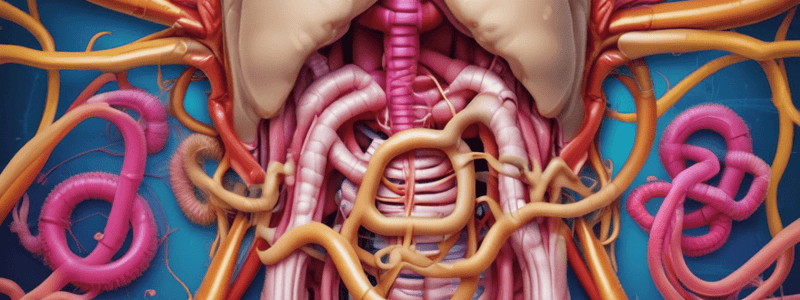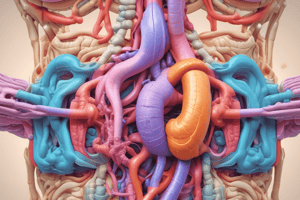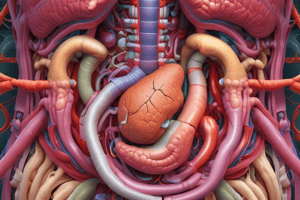Podcast
Questions and Answers
What type of epithelium is found in the stomach and intestines of the GI tract?
What type of epithelium is found in the stomach and intestines of the GI tract?
- Non-keratinized, stratified squamous
- Simple squamous
- Columnar (correct)
- Cuboidal
Which layer of the GI tract contains smooth muscle always in a state of tension?
Which layer of the GI tract contains smooth muscle always in a state of tension?
- Submucosa
- Muscularis
- Muscularis mucosa (correct)
- Mucosa
What is the role of the Muscularis layer in the small intestine?
What is the role of the Muscularis layer in the small intestine?
- Absorbs nutrients
- Exposes food to more chemicals
- Peristalsis – moving food along the canal (correct)
- Secretes mucus
Which organs are classified as accessory digestive organs according to the text?
Which organs are classified as accessory digestive organs according to the text?
Which layer of the GI tract contains dense connective tissue between mucosa and muscularis?
Which layer of the GI tract contains dense connective tissue between mucosa and muscularis?
What type of cells are interspersed with goblet cells in the epithelium of the GI tract?
What type of cells are interspersed with goblet cells in the epithelium of the GI tract?
What is the primary function of the lower esophageal sphincter?
What is the primary function of the lower esophageal sphincter?
Which phase of deglutition (swallowing) is under voluntary control?
Which phase of deglutition (swallowing) is under voluntary control?
What is the main function of the gastric glands in the stomach?
What is the main function of the gastric glands in the stomach?
Which phase of gastric secretion is triggered by the sight, smell, taste, or thought of food?
Which phase of gastric secretion is triggered by the sight, smell, taste, or thought of food?
What is the approximate volume of the stomach when it is empty?
What is the approximate volume of the stomach when it is empty?
What is the primary function of the pyloric sphincter in the stomach?
What is the primary function of the pyloric sphincter in the stomach?
Which layer of the stomach is responsible for holding the alimentary canal in place within the abdominal cavity?
Which layer of the stomach is responsible for holding the alimentary canal in place within the abdominal cavity?
Which nervous system regulates digestive secretions and motility in the alimentary canal?
Which nervous system regulates digestive secretions and motility in the alimentary canal?
What is the primary function of the hepatic portal system?
What is the primary function of the hepatic portal system?
Which region of the peritoneum envelopes the abdominal organs?
Which region of the peritoneum envelopes the abdominal organs?
Which process is NOT a function of the mouth in the digestive system?
Which process is NOT a function of the mouth in the digestive system?
What percentage of the blood pumped by the heart enters the arteries serving the intestines during resting and digesting?
What percentage of the blood pumped by the heart enters the arteries serving the intestines during resting and digesting?
Which of the following statements about the tongue is NOT true?
Which of the following statements about the tongue is NOT true?
What is the primary function of salivary amylase?
What is the primary function of salivary amylase?
Which of the following statements about teeth is correct?
Which of the following statements about teeth is correct?
What is the primary function of the epiglottis during swallowing?
What is the primary function of the epiglottis during swallowing?
Which component of tooth anatomy is covered by cementum?
Which component of tooth anatomy is covered by cementum?
What is the approximate length of the esophagus in an adult human?
What is the approximate length of the esophagus in an adult human?
Which of the following is NOT a function of bile produced by the liver?
Which of the following is NOT a function of bile produced by the liver?
What is the primary reason for the production of methane gas in the chemical digestion process?
What is the primary reason for the production of methane gas in the chemical digestion process?
Which of the following best describes the role of the hepatic portal vein?
Which of the following best describes the role of the hepatic portal vein?
What is the primary function of the Valsalva maneuver in the defecation process?
What is the primary function of the Valsalva maneuver in the defecation process?
What is the primary role of hepatocytes in the liver?
What is the primary role of hepatocytes in the liver?
Which of the following statements about the pancreas is TRUE?
Which of the following statements about the pancreas is TRUE?
Flashcards are hidden until you start studying
Study Notes
Digestive System Overview
- The digestive system, also known as the alimentary canal or gastrointestinal (GI) tract, is about 25 ft long from mouth to anus.
- It has 4 layers: mucosa, submucosa, muscularis, and serosa.
- The system includes the mouth, pharynx, esophagus, stomach, small and large intestines, and accessory digestive organs like teeth, tongue, salivary glands, liver, gallbladder, and pancreas.
Nerve Supply
- The enteric nervous system runs from the esophagus to the anus and is separated into two plexuses: myenteric and submucosal.
- The autonomic nervous system (sympathetic and parasympathetic nerves) extrinsically innervates the alimentary canal.
Blood Supply
- The hepatic portal system transports proteins and carbohydrates to the liver.
- The system delivers nutrients and oxygen to organs of the alimentary canal.
- While resting and digesting, 25% of blood pumped enters arteries serving the intestines.
The Peritoneum
- The peritoneum holds digestive organs in place and has two different regions: parietal peritoneum (lines the abdominal wall) and visceral peritoneum (envelops abdominal organs).
- The peritoneal cavity is the space between the parietal and visceral peritoneum.
Digestive System Processes and Regulation
- The mouth ingests, chews, and mixes food, begins chemical breakdown of carbs and lipids, and moves food to the pharynx.
- The pharynx propels food to the esophagus and lubricates food and passage.
- The esophagus propels food to the stomach and is attached to the mandible, styloid processes, and hyoid bone.
Salivary Glands
- Salivary glands secrete 1-1.5 L of saliva per day, even while sleeping, and produce more while eating.
- Saliva is 95.5% water, 4.5% ions, glycoproteins, enzymes, growth factors, and waste, with a pH of 6.35-6.85.
- Saliva contains IgA and is regulated by the autonomic nervous system.
Teeth
- There are two sets of teeth: 20 deciduous (baby) teeth and 32 permanent teeth.
- Teeth include 8 incisors, 4 cuspids (canines), 8 premolars, and 12 molars, with the third molars (wisdom teeth) erupting toward early adulthood.
Tooth Anatomy
- Gingivae (gums) and the periodontal ligament hold teeth in the socket.
- The tooth consists of the crown, root, pulp cavity, and cementum.
- A cavity is a colony of bacteria feeding on sugar that degrades the enamel.
The Pharynx (Throat)
- The pharynx handles food and air by involuntary muscle contraction and consists of three parts: nasopharynx, oropharynx, and laryngopharynx.
- The epiglottis is pulled over the larynx during swallowing to prevent food from entering the trachea.
The Esophagus
- The esophagus is a muscular tube connecting the pharynx to the stomach, measuring 10 inches in length.
- The esophagus secretes mucous and does not secrete digestive enzymes, with any digestion due to bacteria.
Feces
- Feces consist of undigested food residue, unabsorbed substances, bacteria, old cells from the GI mucosa, inorganic salts, and some water.
- The Valsalva maneuver is a voluntary procedure to remove feces, increasing intra-abdominal pressure.
Accessory Organs
Liver
- The liver receives nutrients from the small intestine through the hepatic portal vein.
- Hepatocytes produce bile, which moves to the common hepatic duct and joins with the common bile duct into the small intestine.
- Bile is essential for emulsification (breakdown) of lipids in the small intestine, and its salts are reabsorbed in the ileum.
- Bilirubin is the main bile pigment, giving stool its color after encountering intestinal bacteria.
The Pancreas
- The pancreas has both exocrine and endocrine functions.
- The pancreas secrets digestive enzymes and hormones like gastrin.
Studying That Suits You
Use AI to generate personalized quizzes and flashcards to suit your learning preferences.




